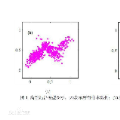Accurate forecasting of bus travel time and its uncertainty is critical to service quality and operation of transit systems; for example, it can help passengers make better decisions on departure time, route choice, and even transport mode choice and also support transit operators to make informed decisions on tasks such as crew/vehicle scheduling and timetabling. However, most existing approaches in bus travel time forecasting are based on deterministic models that provide only point estimation. To this end, we develop in this paper a Bayesian probabilistic forecasting model for bus travel time. To characterize the strong dependencies/interactions between consecutive buses, we concatenate the link travel time vectors and the headway vector from a pair of two adjacent buses as a new augmented variable and model it with a constrained Multivariate Gaussian mixture distributions. This approach can naturally capture the interactions between adjacent buses (e.g., correlated speed and smooth variation of headway), handle missing values in data, and depict the multimodality in bus travel time distributions. Next, we assume different periods in a day share the same set of Gaussian components but different mixing coefficients to characterize the systematic temporal variations in bus operation. For model inference, we develop an efficient Markov chain Monte Carlo (MCMC) sampling algorithm to obtain the posterior distributions of model parameters and make probabilistic forecasting. We test the proposed model using the data from a twenty-link bus route in Guangzhou, China. Results show our approach significantly outperforms baseline models that overlook bus-to-bus interactions in terms of both predictive means and distributions. Besides forecasting, the parameters of the proposed model contain rich information for understanding/improving the bus service.
翻译:对公共汽车旅行时间及其不确定性的准确预测对于服务质量和过境系统的运作至关重要;例如,它可以帮助乘客更好地决定出发时间、路线选择,甚至运输模式选择,并有助于过境运营商就船员/车辆的时间安排和计时制等任务作出知情的决定;然而,大多数现有公共汽车旅行时间预测方法都基于仅提供点估计的确定型模型。为此,我们在本文件中为公共汽车旅行时间制定了巴伊西亚概率预测模式。为了说明连续公共汽车之间高度依赖性/互动的特点,我们可将两辆相邻公共汽车的连接旅行时间矢量和进度矢量参数混为一对,作为新的增强变量和模型,以有限的多变式高斯混合物分布为模式。这种方法可以自然地捕捉附近公共汽车之间的相互作用(例如,相关速度和平稳的进度变化),处理数据缺失值,并描述公共汽车旅行时间分配模式。接下来,我们假设在一天里分享一套相同的高斯运运时程运算要素,但不同的混合路由两条路运量变量连接,作为新的变式变量的模型。这个方法可以自然地捕捉到系统测算系统测算系统测算系统测距的中国的运数据。





